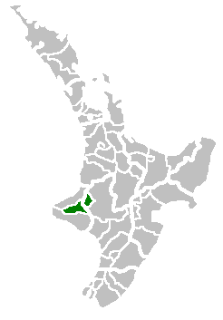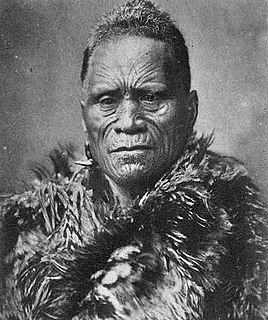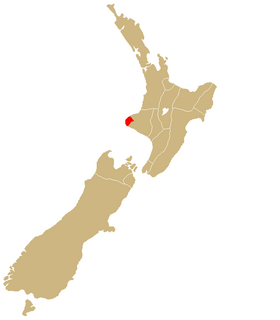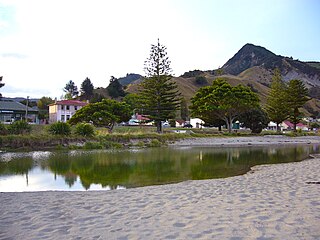
Stratford is the only town in Stratford District, and the seat of the Taranaki Region, in New Zealand's North Island. It lies beneath the eastern slopes of Mount Taranaki/Egmont, approximately halfway between New Plymouth and Hawera, near the geographic centre of the Taranaki Region. The town has a population of 5,740, making it the 47th largest urban area in New Zealand, and the fourth largest in Taranaki.

Tāwhiao was leader of the Waikato tribes, the second Māori King and a religious visionary. He was a member of the Ngāti Mahuta iwi (tribe) of Waikato.

Dame Whina Cooper was a respected kuia, who worked for many years for the rights of her people, and particularly to improve the lot of Māori women. Her wide influence and nationally recognised activity led her to be acknowledged with awards in both the British (Imperial) and New Zealand Royal Honours Systems, and by her own people, who bestowed the title Te Whaea o te Motu upon her.

Okato is a small township in rural Taranaki, New Zealand. The population was 561 in the 2013 census, an increase of 30 from 2006. It is situated about 25 minutes drive around the coast from New Plymouth on State Highway 45. Oakura is 12 km to the north-east, and Warea is 9 km to the south-west. The place offers popular rocky surfing spots around coastal beaches.

Te Āti Awa is a Māori iwi with traditional bases in the Taranaki and Wellington regions of New Zealand. Approximately 17,000 people registered their affiliation to Te Āti Awa in 2001, with around 10,000 in Taranaki, 2,000 in Wellington and around 5,000 of unspecified regional location.

Oakura is a small township in New Plymouth District, Taranaki, in the western North Island of New Zealand. It is located on State Highway 45, 15 kilometres south-west of New Plymouth. Okato is 12 km further south-west. The Oakura River flows past the town and into the North Taranaki Bight. To the south is the Kaitake Range, part of Egmont National Park.

Urenui is a settlement in northern Taranaki, in the North Island of New Zealand. It is located on State Highway 3 close to the shore of the North Taranaki Bight, 13 kilometres east of Waitara and 6 km south-west of Mimi. The Urenui River flows past the settlement into the North Taranaki Bight.

Kura Kaupapa Māori are Māori-language immersion schools (kura) in New Zealand where the philosophy and practice reflect Māori cultural values with the aim of revitalising Māori language, knowledge and culture. The term Kaupapa Māori is used popularly by Māori to mean any particular plan of action created by Māori to express Māori aspirations, values and principles.
Harry Delamere Barter Dansey MBE was a New Zealand Māori journalist, cartoonist, writer, broadcaster, local-body politician, and race relations conciliator.
Te Kumeroa "Ngoingoi" Pēwhairangi, QSM was a prominent teacher of, and advocate for, Māori language and culture, and the composer of many songs. She spearheaded the Māori Renaissance in the late 1970s and early 1980s.

Clifford Hamilton Whiting was a New Zealand Māori artist, heritage advocate and teacher. Whiting was born and raised in Te Kaha, New Zealand, and affiliated to the Te Whānau-ā-Apanui tribe.

James Henry Pope (1837–1913) was a New Zealand teacher, school inspector, educationalist, amateur astronomer and writer. He was the first Inspector of Native schools in New Zealand in 1980. Pope was one of the founders of the Polynesian Society and was its President from 1899 to 1900. He was the father of the poet, cricketer and teacher Robert J. Pope
Fanny Louise Irvine-Smith was a New Zealand teacher, lecturer and writer.
Kohai Grace is a New Zealand weaver. Her iwi are Ngāti Toa Rangatira, Ngāti Porou, Te Āti Awa and Ngāti Raukawa.

Charles Wilson Hursthouse, also known by his Māori name Wirihana, was an English-born New Zealand surveyor, public servant, politician, and soldier. He laid out part of the North Island Main Trunk railway through the King Country.
Marama Isabel Martin was a New Zealand television and radio broadcaster. She was the first person seen on colour television in New Zealand, and was the last person to appear on NZBC TV.

Susana Tetane Lemisio is a community organiser and educator from Tokelau.
The 2010 New Year Honours in New Zealand were appointments by Elizabeth II in her right as Queen of New Zealand, on the advice of the New Zealand government, to various orders and honours to reward and highlight good works by New Zealanders, and to celebrate the passing of 2009 and the beginning of 2010. They were announced on 31 December 2009.
Shavaughn Ruakere is a New Zealand Māori actress and television presenter. She is best known for her role as Roimata Ngatai on the prime-time soap opera Shortland Street.





















